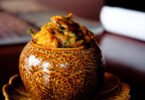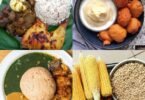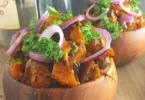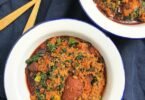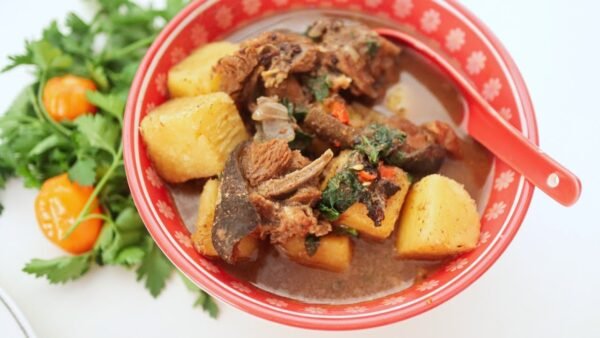
The Esan people—habitants of Edo State in Nigeria—are no exception when it comes to colourful and appetising culture meals. This Esan food is therefore seen as an expression of the farming, imaginative, and communitarian culture. Taking advantage of the newly available ingredients easy to find in the Esan region, the Esan has crafted a diverse sustainable cuisine with strong ties to its heritage.
This article focuses on the most colourful of Esan dishes, how they are prepared, and the meaning behind each dish.
1. Black Soup (Ofe Omo): The Signature Dish
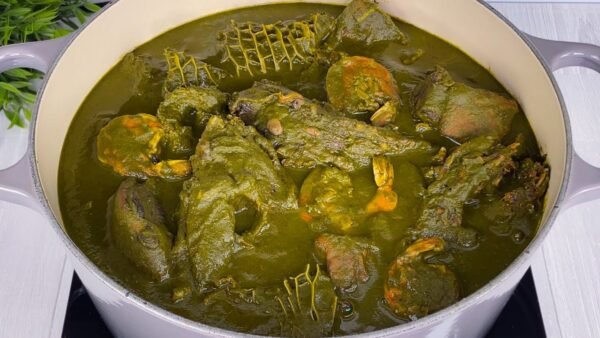
Black Soup, or Ofe Omo, is a beloved Esan delicacy renowned for its rich flavour and medicinal properties. It gets its dark colour from a blend of local herbs and leaves, including Efirin (scent leaf), Uziza, and sometimes Bitter Leaf.
Preparation:
- The leaves are washed and then ground into paste form.
- Smoked fish, meat, and spices are added to the palm kernel oil, which is used as the base ingredient for this dish.
- The soup is cooked until it attains its unique aroma and taste for it to be considered ready.
Cultural Significance:
- Black Soup qualifies as rather a helpful dish that is cooked for nursing ladies and for people who are recovering from an illness.
- Its preparation bears testimony to the fact that the Esan people have a remarkable understanding of some local herbs and their effects on the human body.
2. Ukodo (Yam Pepper Soup): A Comforting Delicacy

Ukodo, also known as yam pepper soup, is a hearty dish often enjoyed during festive occasions or cold weather. It combines yam with a spicy broth made from goat meat or fish.
Preparation:
- Yam is peeled, cut into chunks, and boiled in a spiced broth.
- Key spices include pepper, ginger, garlic, and Uziza seeds, which give the dish its bold flavor.
- Goat meat or fish is added for protein, making it a filling and satisfying meal.
Cultural Significance:
- Ukodo is a traditional dish for expectant mothers, believed to provide strength and nourishment.
- It is also a favorite at family gatherings, symbolizing warmth and hospitality.
3. Eba and Black Palm Nut Sauce
It is common knowledge that Eba, which is made from cassava flakes known as garri, is widely consumed in Esanland. This is very delicious when eaten there with the Black Palm Nut Sauce, making it a meal that is flavoured with the culture.
Preparation of Eba:
- Cassava flakes are prepared by pouring hot water into the flakes and mixing the contents until they become a thick, rounded mass.
Preparation of Black Palm Nut Sauce:
- The palm nuts are boiled and then pounded to come up with the pulp, which is full of oil.
- It is prepared by boiling the pulp of the plant in smoked fish, meat, and spices to producea thick soup.
Cultural Significance:
- This combination is a go-to meal during celebrations, symbolising abundance and gratitude.
- The use of palm nuts highlights the Esan people’s reliance on agricultural resources.
4. Rice and Native Spices
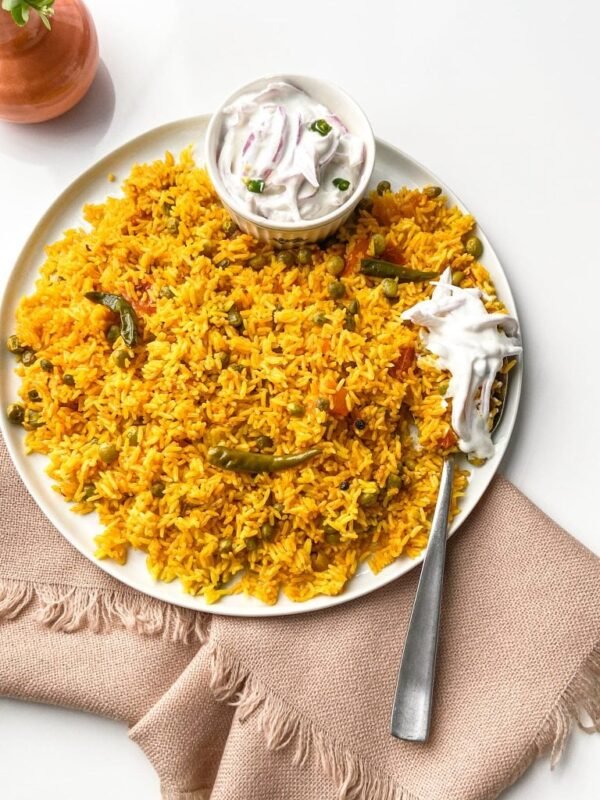
Rice, a common food staple, is transformed into a unique Esan dish through the addition of native spices and palm oil. This meal is often served with vegetables or fish.
Preparation:
- Rice is cooked with palm oil, onions, and a blend of local spices, giving it a rich golden color.
- Vegetables like spinach or pumpkin leaves are added for extra flavor and nutrients.
Cultural Significance:
- This dish is popular during communal events, reflecting the Esan people’s love for shared meals.
- It is also served as an offering during traditional festivals, symbolizing unity and prosperity.
5. Agidi (Corn Pudding)
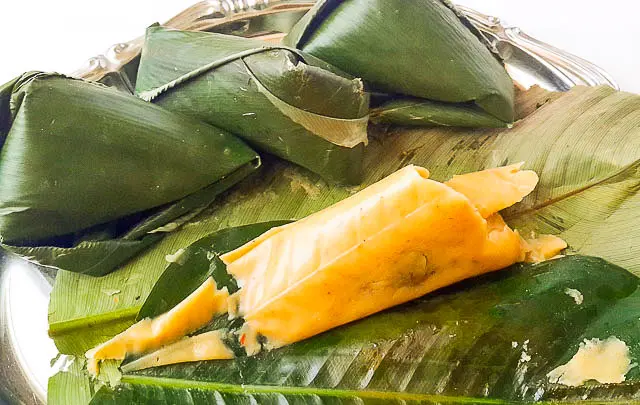
Agidi, a smooth corn-based pudding, is a versatile Esan food that pairs well with a variety of soups and sauces. It is especially appreciated for its light and satisfying texture.
Preparation:
- Corn flour is mixed with water to form a batter.
- The mixture is cooked over low heat while being stirred continuously to achieve a smooth consistency.
- It is molded into small portions and wrapped in leaves for presentation.
Cultural Significance:
- Agidi is a practical and portable food, often served during outdoor ceremonies or as a travel meal.
- It reflects the Esan people’s resourcefulness and ability to create delicious meals from staple crops.
6. Ogbono Soup: The Versatile Dish
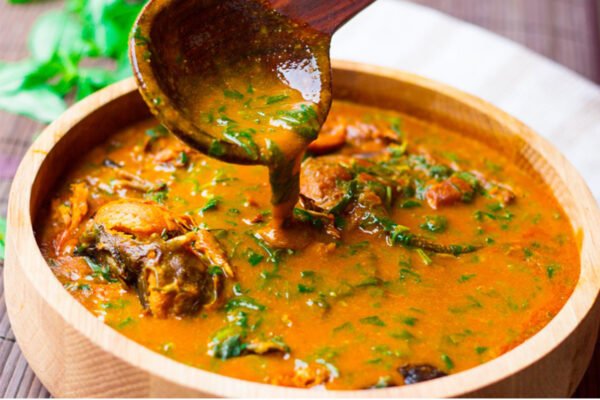
Ogbono soup made from power derived from the ground wild mango seed is also one of the favourite meals of the Esan man. Due to its thickness and stickiness, we like it because of its nutty flavour.
Preparation:
- The seeds can be processed to a powdered form, then mixed with palm oil, meat, fish, etc. and prepared.
- Some vegetables are added for colour and nutritional value, especially pumpkin leaves or bitter leaves.
Cultural Significance:
- Thus, there is nothing complicated about Ogbono soup, and it can be spotted with eba, pounded yam, or rice.
- It is also associated with the ability to find a convenient way in all complex situations, which the Esan people consider valuable.
7. Traditional Cooking Techniques in Esan Cuisine
The Esan people use various cooking methods, that demonstrate their innovation in utilising nature resources and concern to retain the essence of the food.
Key Techniques:
- Boiling and Steaming: Used for dishes like Agidi and Ukodo, ensuring the food retains its natural flavours.
- Pounding: A method used for extracting palm oil from nuts or creating smooth textures in dishes like pounded yam.
- Smoking and Grilling: Essential for preserving fish and meat, giving them a distinct, smoky flavour.
- Herbal Blending: Herbs are skilfully combined to enhance the taste and medicinal value of soups like Black Soup.
8. The Role of Esan Cuisine in Social Life
Food is everyone’s companion in Esan society, and meals are used to show love, appreciation, or togetherness.
- Festivals: Pangan is prepared with portions of meat and potatoes, which are placed at the centre of the dish, and Ukodo is a traditional festival dish.
- Marriage Ceremonies: Foods are elaborated to signify the marriage of the bride and groom and the hospitality of the family as cooks.
- Spiritual Practices: Some of the foods offered are taken to the deities or ancestors during a ritual proving the religious aspect of food.
9. Preservation of Esan Culinary Heritage
It could be said that in the conditions of the modernisation processes, the Esan people still actively use folklore and customs about the dishes, preserving them through festivals, narratives, or cooks’ interactions. The documentation of these actions is very important in the following generations to embrace their ancestors’ wealth.
Conclusion
Esan people’s food is therefore one of the best examples of creativity, endurance and appreciation of their environment. All of them have a history behind them and include the nutritious Black Soup or the cozy Ukodo. Therefore, the Esan people continue to cook their meals as their ancestors cooked them and make the world a richer place.


